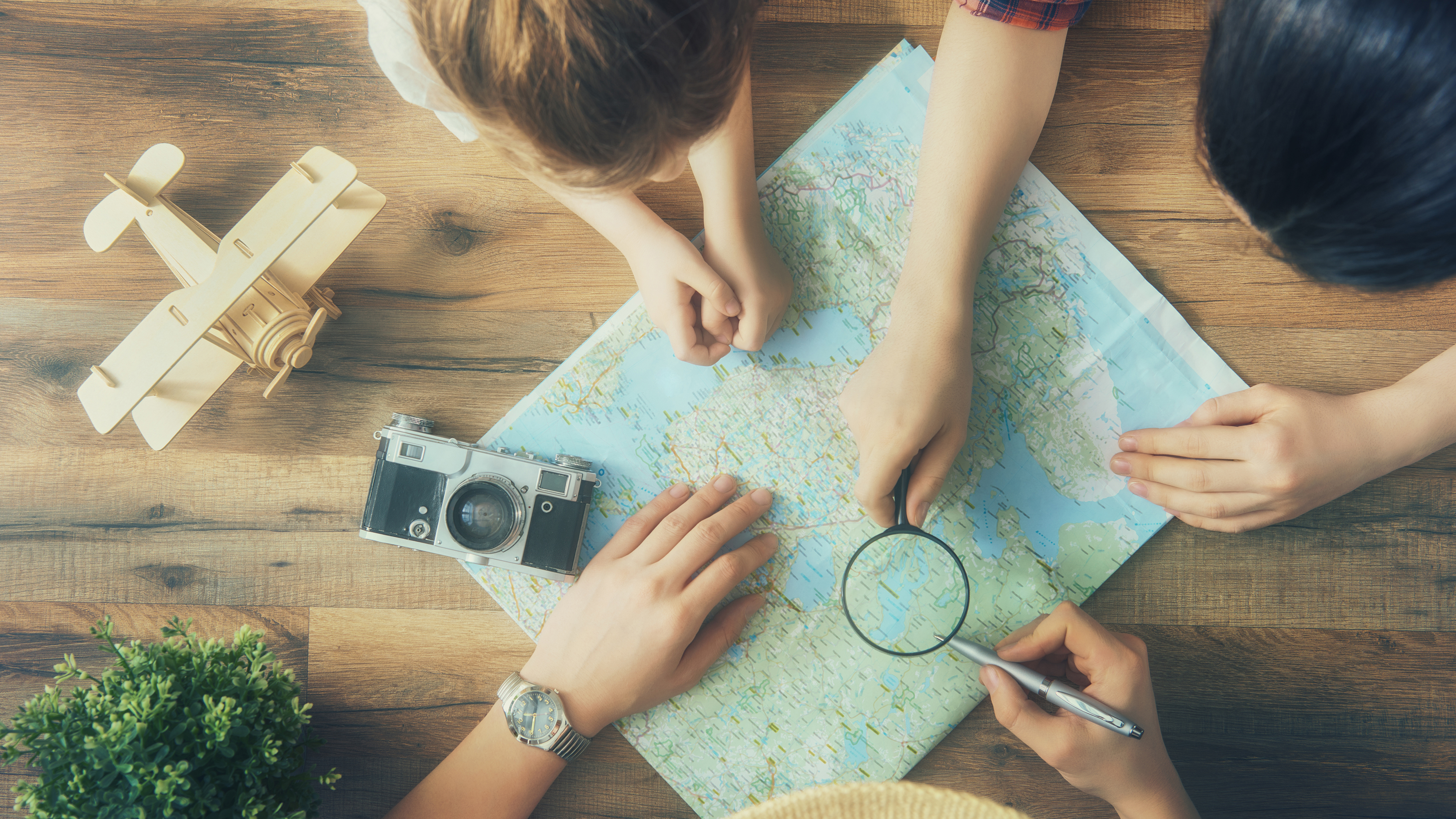5 min read
5 Tips to Teach Social Studies At Home
By: Shannon English, Rachel Glass, and Brian Giel on Apr 17, 2020 3:30:43 PM

When it comes to teaching your children history from home, remind them that they are living it! Americans have never experienced state-mandated school closures and social distancing regulations, nor have they experienced an economic downturn caused by a pandemic.
To help you, the parent educator, Lincoln Learning’s team of social studies curriculum developers provided five tips for incorporating social studies into your child’s everyday life. Recommendations are provided for grades K-12.
Tip 1: Address the Situation
Elementary (K-6): Have a discussion with your student about the topics they see while watching the news or reading it online. Ask their opinions on the subject at hand. Challenge them to think beyond a yes or no answer and ask them to tell you why they feel a certain way.
Secondary (7-12): Read or watch a news story about current events with your student and remind them that the story could be a primary or secondary source on the world today. After reading or watching the story, ask your student to consider the following information:
- What is the main argument or purpose of the story?
- Who is presenting the information?
- Why is the story being presented?
- What questions do you still have after finishing the story?
- Can you easily find more information based on your questions?
These questions can help you and your student analyze the story while discovering how information is presented and where they can find additional details.
Tip 2: Take a Virtual Field Trip
Many museums offer kid-friendly virtual tours and taking a virtual field trip is easier than ever. Several fantastic field trips are listed below and appropriate for any age group.
- During a virtual tour of the Smithsonian National Museum of Natural History, students can check out dinosaur skeletons and animals from around the world. The Smithsonian also offers a wide variety of follow-up activities and readings for after the tour.
- Visit the British Museum to see a real-life mummy during an interactive tour. Students can also discover all sorts of interesting objects, including a papyrus poem from ancient Egypt.
- You and your student can also take a virtual tour of the Heinz History Center to see past and current exhibitions.
Tip 3: Study Local History and Geography
Purchase a globe, an atlas, or a wall map to take a deeper look at the history and geography of your community, state, and country. Ask your student the following questions as they are investigating.

Primary Student Questions (K–6):
- What is the climate?
- What physical features can you find near the area in which you live?
- Are there any natural resources in the area?
- What sort of natural disasters may happen there?
Intermediate Student Questions (6–8):
- What physical landforms do you see, such as mountains, rivers, lakes, and oceans?
- Where are the major cities and towns located in relation to major landforms?
- Why do you think cities and towns grew in specific areas?
- What challenges do you think people have living in these cities and towns?
- What do you think the climate is like in these cities and towns?
Secondary Student Questions (9–12):
Ask your student to select a country they are not familiar with and investigate it. Then, ask them how that country compares to their own. Ask these questions:
- What are some similarities and differences in climate between the investigated country and the country in which you live?
- How are the investigated country’s physical features similar to and different from the physical features of your home country?
- What natural resources does the investigated country have? What are the natural resources in your home country? Are there any natural resources that both countries must import?
- Have any natural disasters occurred in the investigated country? What natural disasters has your home country faced? Why might these disasters be similar or different? For help, prompt your student with factors such as location, climate, population, etc.
Tip 4: Create a Primary Source
Have your student write in a journal to create a primary source.
Primary (K-6) – Elementary students can draw a picture or write a few sentences on how they feel during this historical pandemic. Students can also draw or write about what they are doing during the quarantine to pass the time.
Intermediate (6-8) – Students can create a journal about their life during the pandemic. This journal will be a primary source that tells the story of their life. They can write as often as they like, such as once or twice a week or every day, if they choose. For each entry, ask them to write about their day, life in their home, or what it was like completing their schoolwork and other projects from home. In their journal, they can also write about future plans, such as what they want to achieve in the upcoming months.
Secondary (9-12) – Students can write a journal entry about what life is like for them during the historical pandemic of 2020. Encourage them to explain what the pandemic is, how it has impacted their daily life, how it makes them feel, and what they think the future will be like after the pandemic.

Tip 5: Use Games as Teaching Tools
Plan a family game night. Some of the most popular family board games easily lend themselves to reinforcing social studies concepts.
- Monopoly Jr. (ages 5-8) and Monopoly (ages 5 and up) can be used to teach money management, decision making, purchasing, and organization (keeping track of the properties you own). Plus, Monopoly comes in many different versions and themes that can suit anyone’s personal preference.
- Life (ages 8 and up) can be used to introduce a younger audience how to follow the rules of the game. It can also help children to begin problem solving and build logic as it simulates a person’s travels through his or her life, from college to retirement.
- Risk (ages 8 and up) can be used to develop critical thinking skills regarding strategy and management of resources by mimicking decisions of leaders and generals of the past. The game Battleship can be used for similar skill-building concepts.
- Sim City, The Sims, or Animal Crossing (ages 10 and up) give students an idea of what it’s like to plan a city, manage a town, and keep its citizens happy.
- Civilization (ages 12 and up) is a more complex game that teaches students about growing a nation, diplomacy, border expansion, and international trade.
 Shannon English is the EK-5 English Language Arts and Social Studies SME Coordinator at Lincoln Learning Solutions and has been with the company for five years. She has a Bachelor of Arts in Elementary Education and Special Education and is currently pursuing a certification in Instructional Design. Shannon is married with two children – Alayna, 9 and Kaelyn, 6.
Shannon English is the EK-5 English Language Arts and Social Studies SME Coordinator at Lincoln Learning Solutions and has been with the company for five years. She has a Bachelor of Arts in Elementary Education and Special Education and is currently pursuing a certification in Instructional Design. Shannon is married with two children – Alayna, 9 and Kaelyn, 6.

Brian Giel has been with Lincoln Learning Solutions since 2013 and is currently the Lead of Middles School Social Studies. He has participated in the development of more than ten of Lincoln Learning Social Studies courses. In his spare time, Brian enjoys bike riding, walking his dog, and miniature painting.
 Rachel Glass is a Social Studies Lead for grades 9-12. She has more than six years of online curriculum experience. Rachel spends her free time cooking and doing outdoor hobbies with her husband and three children.
Rachel Glass is a Social Studies Lead for grades 9-12. She has more than six years of online curriculum experience. Rachel spends her free time cooking and doing outdoor hobbies with her husband and three children.
Related Posts
Bring Culture into Your Classroom This Holiday Season
The winter months are busy with holiday celebrations and family traditions. It’s a time where...
Back-To-School Tips for Online Learners
Fall can be a challenging time of year for students who use WiFi cables to get to school instead of...
Build a Successful High-Impact Tutoring Program for Online Learners
High-impact tutoring has proven to be an effective strategy for increasing student learning;...